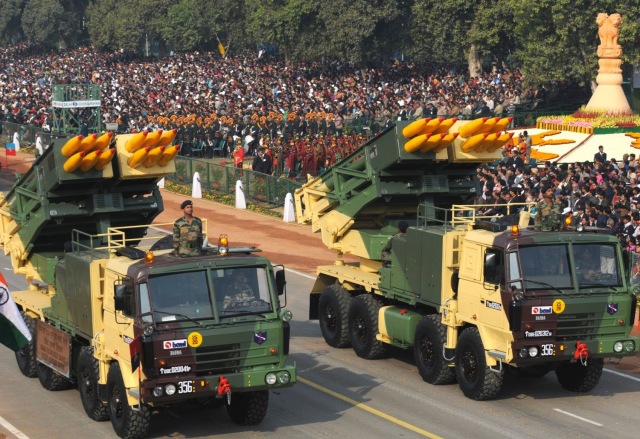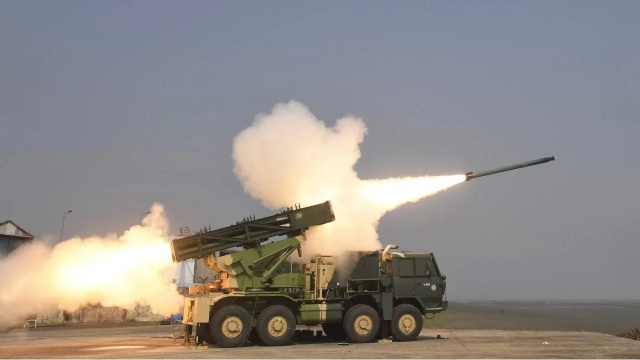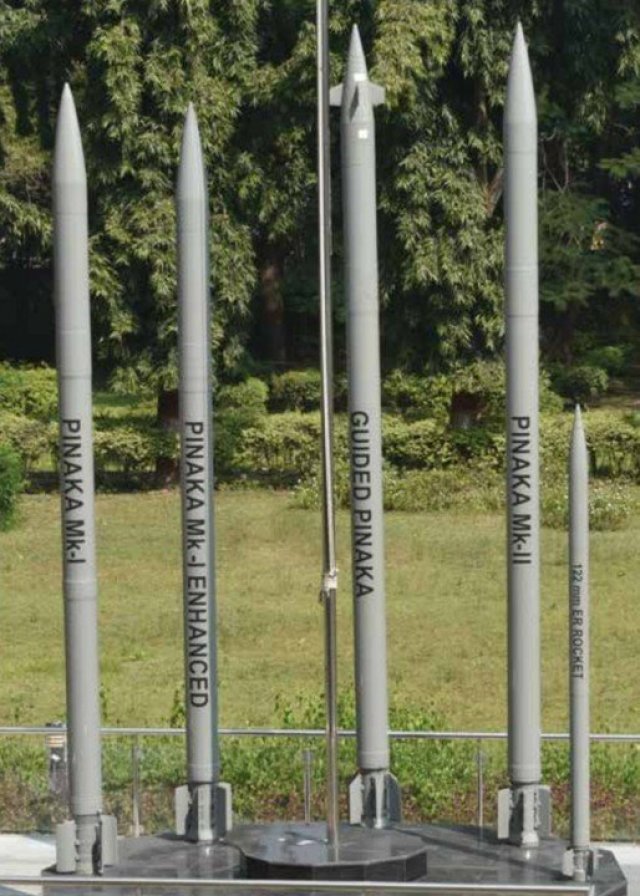The Indian newspaper "The Economic Times" in the article by Manu Pubby "Arming Armenia: India to export missiles, rockets and ammunition" ("Arming Armenia: India will export missiles, rockets and ammunition") She reported that Armenia has signed a major contract worth more than $ 250 million for the purchase of weapons in India, including Indian 214-mm Pinaka multiple launch rocket systems and rockets for them, unnamed anti-tank missile systems and various ammunition.

Combat vehicles of the Indian 214-mm multiple rocket launcher Pinaka Mk I at the military parade in New Delhi (c) indigenousindiandefense.blogspot.comIndia has signed a major contract for the export of missiles, rockets and ammunition to Armenia, as this Asian [sic!
] the country is involved in a protracted border conflict with neighboring Azerbaijan. A number of contracts were signed on an intergovernmental basis for the supply of weapons and ammunition to Armenia earlier this month.
Although the value of the contracts has not been disclosed, it is assumed that weapons worth more than 2,000 crore rupees (more than $ 250 million) will be delivered to Armenia in the coming months. India is making significant efforts to increase arms exports, with the reform of [export] policy and active government support for receiving foreign [defense] orders.
Sources told ET that the contract includes the first ever export sale of nationally developed Pinaka multiple launch rocket systems, which are already in service with the Indian Army. This powerful weapon was developed by the Indian Defense Research and Development Organization (DRDO) and is produced by private companies in India. The Indian Army recently placed orders for six additional regimental sets of MLRS Pinaka [18 combat vehicles each. - bmpd], and is also testing extended-range missiles for it.
As part of the comprehensive deal, India will also supply anti-tank missiles and a number of ammunition to Armenia. This is not the first time that weapons systems have been exported to Armenia. In 2020, India beat competitors from the region and supplied this country with four Swathi radars for about 350 crore rupees ($44 million). These radars, developed in accordance with the requirements of the Indian Army, are used to detect artillery shells, mortar mines and rockets, as well as to accurately determine the location of enemy launchers and artillery positions. These radars have been successfully used by [the Indian Army] on the borders with Pakistan and China.
India is making purposeful efforts to increase exports of defense products, with the aim of increasing sales of military equipment and equipment abroad to the amount of 35,000 crore rupees (4.4 billion dollars) per year by 2025. Last year, annual exports of defense products were close to 13,000 crore rupees ($1.62 billion), mainly due to the private sector.
In another article on this topic, Manu Pubby "First Pinaka export: Private companies to lead from front" ("The first export of Pinaka MLRS: Private companies are leading in promotion") The Economic Times newspaper reports that private companies are leading in the first export contract concluded by India for the sale of nationally developed Pinaka multiple launch rocket systems, and the bulk of orders will be carried out by industry partners who have created production facilities and contractor chains for fast delivery.
Armenia, which has placed orders for four Pinaka MLRS batteries (two batteries should be delivered first, and the same additional order is in the option and should be delivered later), will also receive in the near future a number of new extended-range rockets [for Pinaka] being developed for the Indian army, as well as guided missiles for her. A number of Western Asian countries, as well as the armed forces of Southeast Asian countries, which are seeking to increase their firepower, are also showing interest in this Indian-developed system.
Private sector companies cooperating with the Indian Defense Research and Development Organization (DRDO) - Larsen & Toubro, Tata Defense and Economic Explosives Limited - have created production lines for the production of Pinaka systems, which are supplied to the Indian armed forces in whole sets. These companies are already fulfilling orders for six regimental sets of Pinaka MLRS for the Indian Army, in addition to the four regiments of this MLRS that are already in service. As part of the larger plans to modernize the artillery of the Indian Army, only 22 MLRS regiments are required.
The six regimental sets of Pinaka MLRS ordered by the Indian Army include 114 combat vehicles-launchers with an automated fire control system and 45 command posts, and the program has more than 70% components of national production. The current order of the army gives Indian companies good opportunities to carry out rapid deliveries of Pinaka systems to Armenia, the deliveries of which can begin within a year.
On the bnpd side, we recall that the Pinaka 214-mm 12-barrel long-range MLRS was one of the Indian long-term military projects and was developed by DRDO since the early 1980s, but it was painfully refined for a long time, mainly due to the unsatisfactory characteristics of the scattering of missiles. The prototype vehicles were delivered to the Indian Army for military testing in 1999-2000, but the actual deliveries of four serial regimental kits (three batteries of six combat vehicles each) in the Pinaka Mk I variant were carried out as part of the joint production of Tata Power SED and Larsen & Toubro's Heavy Engineering Division in 2006-2017 (total with training and spare was 80 combat vehicles were delivered).
The firing range of standard Pinaka Mk I MLRS missiles weighing 277.4 kg (100 kg warhead weight) is up to 37.5 km, the missiles are designed and manufactured by the Indian company Solar Industries with assembly at Indian state-owned enterprises in Chandra and Badmala. The MLRS battery includes two command posts, a weather radar vehicle, six 12-barrel combat vehicles, six transport-loading vehicles and three transport vehicles. All of them are made on Tatra T813 and T815 (8x8) automobile chassis, assembled under license by the Indian state company Bharat Earth Movers Limited (BEML). Command posts and MLRS combat vehicles use the integrated Indian Army Artillery Artillery Command & Control System (ACCS) developed by DRDO. The Pinaka Mk I MLRS regiments are attached to the Swathi WBRL artillery reconnaissance radar.
In August 2020, the Indian Ministry of Defense awarded the industry a contract worth 2,580 crore rupees ($350 million at that time) to supply him with six more regimental sets of Pinaka Mk I MLRS by the end of 2024, including 114 combat vehicles and 45 command posts. In total, the Indian army plans to have 22 Pinaka MLRS regiments, and to purchase 189 thousand missiles for them.
In 2020-2022, successful tests were conducted of a modified Pinaka Mk I Enhanced missile with a range increased to 45 km, which was declared ready for mass production. For a long time, DRDO has also been developing an upgraded version of the MLRS, designated Pinaka Mk II, and which should use new missiles in variants with an extended range of up to 60 km and up to 90 km, as well as Guided Pinaka corrected missiles with a range of up to 75 km, equipped with an inertial satellite guidance system. Pinaka Mk II should also use modules with new long-range (40 km) 122-mm ER missiles of Indian design. Tests of the Pinaka Mk II have been underway since the beginning of 2013, but have not yet been completed. The development of the Guided Pinaka corrected high-precision missile was also conducted neither shakily nor smoothly, but in the summer of 2022 a contract was issued for their accelerated development and the start of serial production under the impression of the successful combat use of American GMLRS missiles in Ukraine.
Armenia thus became the first foreign customer of the Pinaka MLRS.

Indian 214mm Multiple Launch Rocket System Pinaka Mk I Combat Vehicle (c) Ministry of Defense of IndiaIndian Multiple Launch Rocket System Pinaka (c) defenceforumindia.com

